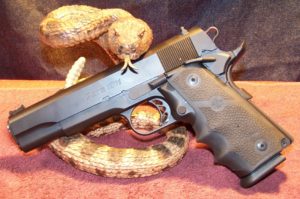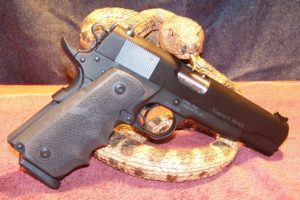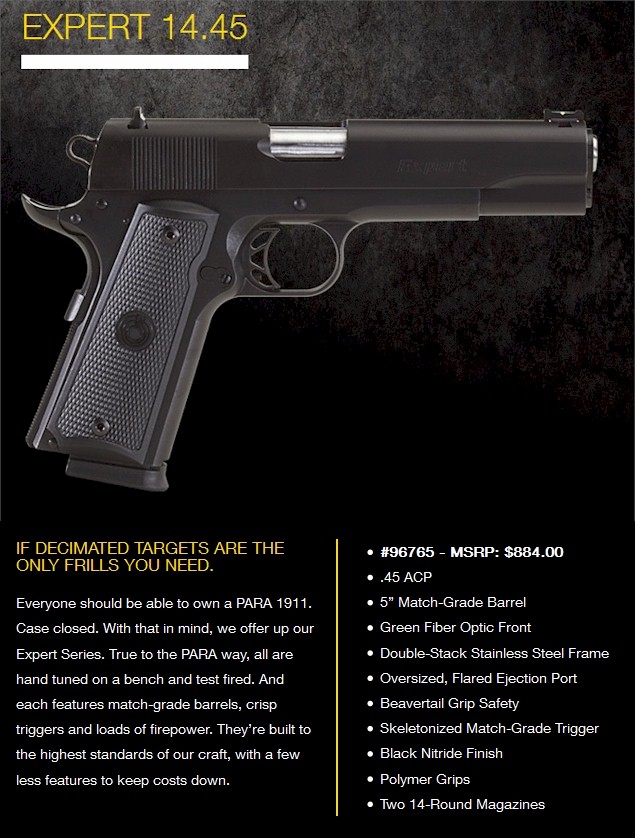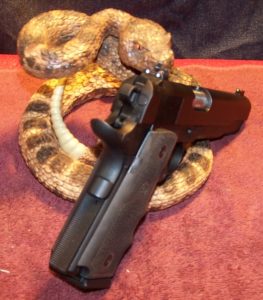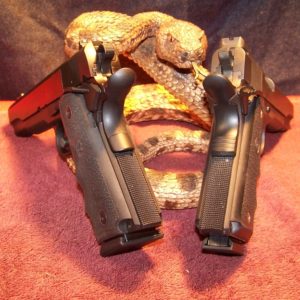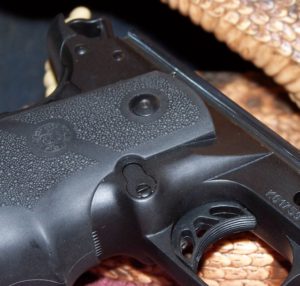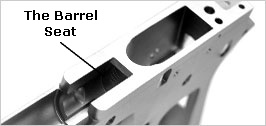The PARA-USA 14.45 1911-based pistol has always been controversial. Para-USA was the first to manufacture a high-capacity 1911 that was “large and in charge” and it does take some large hands to fulfill its mission.
I purchased my PARA-USA “Expert” 1911 and the “Expert” 14.45 around the same time in 2013. And, like the PARA “Expert” in the 8-round version, the PARA-USA 14-45 had not yet been shot since its purchase. That was about to change.
Although the PARA-USA 14.45 is a 1911-based pistol, and it does share the 80-Series trigger concept as the 8-round version, there are some obvious differences and challenges that had to be faced by PARA-USA when they decided to go “high capacity” and the least of which was appeal – the 1911 platform already had that among many. Was fourteen rounds of .45 ACP in a heavy handgun something somebody really wanted to carry around? There were; however, large capacity pistols that fired the .45 ACP round already on the market; the polymer Glock G21 comes to mind with its 13-round capacity, but a high-capacity, all steel 1911 may be one of those pistols that would make some ask why bother. Well, you really have to be a 1911 fan to really understand the Zen factor of the 1911. And to really appreciate the PARA-USA 14.45, you really need to see it up close. So, here we go!
THE BASICS:
Of course, the specifications do not tell you the whole story, and here are a few of the blanks that need to be filled:
- Slide width: 0.92 inches
- Weight: 42.4 ounces (unloaded w/magazine inserted)
- Maximum grip width (w/standard polymer grip panels): 1.35 inches
- Maximum grip width (w/Hogue rubber wraparound grips – finger groove): 1.410 inches
- Grip span (from rear to Hogue rubber wraparound grips finger groove inset): 2.106 inches
- Trigger Pull Weight: 5.4 pounds
- 1911 Series: 80
FIT N’ FINISH
I have to say that the PARA-USA 14.45 is one of the tightest pistols that I have had the pleasure to hold. This is one pistol that you must use the barrel wrench to remove the barrel bushing.
There is absolutely no side-to-side play between the slide and frame.
The black Nitride finish is evenly applied and is very appealing.
SLIDE
The black Nitride finish is evenly applied and is very appealing in that it provides a satin finish to the slide, which is in slight contrast to the frame.
Dovetail cuts for the sights allow for removal or adjustment.
PARA 1911 is roll-marked on the left side of the slide while EXPERT 14.45 is roll-marked on the right side.
The barrel is a stainless steel match-grade unit with integral feed ramp. While not highly polished the feed ramp is polished. Full cartridge case support is provided.
A “Peek-See” slot (the true technical term for what is known as a Loaded Chamber Indicator) is milled into the rear of the barrel that allows you to “Peek ‘n See” if a cartridge is chambered. It seems that this method of verifying that a pistol is loaded is becoming popular. Of course, the use of a standard guide rod system allows the proverbial “press check” and we 1911 veterans usually prefer it.
The PARA-USA 14.45 utilizes the standard JMB swing-link design and a standard guide rod that will make 1911 purists happy. I would put the recoil spring somewhere in the eighteen pound range. Combined with a strong hammer spring, you will be happy for the serrations when you need to pull the slide to the rear with the hammer down.
Vertical serrations at the rear of the slide make for a good hold for which to move the slide rearward.
The slide is excellently machined and incorporates the “80-Series” safety button that prevents the firing pin from moving forward unless the trigger is pulled.
SIGHTS
The PARA-USA 14.45 comes equipped with an excellent set of sights, although they are a bit small for my liking, but they are probably adequate for most.
The front side is a small fiber optic unit that is dovetailed into the slide. The center of the optic sits approximately 0.525 inches above the bore-line.
The rear sight is a two-dot unit that, like the front sight, is dovetailed into the slide. The rear sight can be drifted for windage, but no provision is available for elevation. Note that the rear sight is more like a standard G.I. sight in that it does not slope rearward like you might find in the case of a NOVAK sight. The rear upright sight could allow for racking of the pistol’s slide, using a hard surface, in an emergency where one hand is disabled
FRAME
The frame is black-nitride treated stainless steel and is the “Mack-Daddy” of 1911 frames. You can’t talk about the frame without talking about the grip; it is “Wide-Body” to say the least. If you have small or a thick hand, you will not like the PARA 14.45.
To put things into perspective, the grip width of the Glock G21 is approximately 1.27 inches. The maximum grip width of the PARA 14.45 is about 1.35 inches. With the grip sleeve that I have on my G21, the grip width is almost equal to that of the PARA 14.45 with the Hogue Rubber Wraparound Grip with Finger Grooves installed – and I like it!
The frame is complete with a left-side only extended thumb safety, a well-fitted beaver-tail grip safety with memory bump, and nicely-checkered mainspring housing. In addition, there are vertical serrations on the front of the grip to provide some king of purchase on the grip for the hand.
The magazine release button is extended and is left side only as is common with the 1911. The reach to the magazine release might prove difficult for some, but I have no problem reaching it without changing my grip, but then again, I have somewhat long digits.
As with most 1911 pistols, the plunger tube is a staked unit.
PROCEED WITH CAUTION!
The frame has one feature that I do not care for and that is the lack of Grip Screw Bushings as would be found on most other 1911 frames. Essentially what this means is that you had better be right in tightening the grip screws should you ever decide to swap the grip panels for something better. With a standard 1911, if you booger-up (that is the technical term, by the way) a grip screw bushing you can simply remove the damaged Grip Screw Bushing and replace it with a new one. If you screw up the grip screw threads on the PARA-USA 14.45, it is a guaranteed trip to your local gunsmith. Luckily, I was able to use the grip screws that came with the pistol to mount the Hogue Rubber Wraparound Grip without problems. It is just something that you need to be aware of with the PARA-USA 14.45.
Note
If you decide to change out the grip panels with thinner grip panels, you must use shorter grip screws than what comes with the pistol to prevent the grip screws from protruding into the magazine well.
SAFETIES
The one thing that can be said about the 1911 pistol is that once you get used to the safeties on one 1911 they are in the same location as any other 1911.
The PARA 14-45 comes with the usual thumb and grip safety that are considered “dynamic” safeties; the operator must do something to activate or deactivate them. The 80-Series safety is; however, a passive safety that is internal to the pistol. The 80-Series safety; however, is always in play until the trigger is pulled by the operator, so one might say that the 80-Series safety is an “active safety. However, the 80-Series safety block the firing pin from moving forward if the pistol is dropped.
As with all 1911-based pistols there is a half-cock notch that holds the hammer away from the firing pin. This half-cock notch could be considered the same as the half-cock position in a single-action revolver; the 1911 is a single-action pistol after all. However, it is not desirable to use the half-cock notch as a safety mechanism in a 1911. If enough sudden force is applied to the hammer, as there would be if the pistol was dropped on the hammer, the half-cock notch could be defeated and the hammer could impact the firing pin with enough force to ignite the primer in a loaded cartridge. The “firing pin block” prevents the firing pin from moving forward until the firing pin block clears the firing pin by pulling the trigger. How it accomplishes this is shown in the figure that follows.
While an “80-Series” 1911 can be converted to a “70-Series” 1911, I do not condone doing so in a pistol that even remotely might be used for self-defense purposes.
TRIGGER
 Let’s just say that the trigger in an 80-Series 1911 is not as good as a trigger in a 70-Series 1911 and leave it at that, because the trigger in the PARA-USA 14.45 could serve as the poster child for that statement. That is not to say that the trigger is bad. It is to say that I would prefer a 70-Series trigger over the one in the PARA 14.45. With that said, the trigger is new, will be broken in through use, and will get better. How much better is questionable and it just might take a trip to my favorite qualified and certified armorer to make it as good as it can be.
Let’s just say that the trigger in an 80-Series 1911 is not as good as a trigger in a 70-Series 1911 and leave it at that, because the trigger in the PARA-USA 14.45 could serve as the poster child for that statement. That is not to say that the trigger is bad. It is to say that I would prefer a 70-Series trigger over the one in the PARA 14.45. With that said, the trigger is new, will be broken in through use, and will get better. How much better is questionable and it just might take a trip to my favorite qualified and certified armorer to make it as good as it can be.
Breaking at about 5.4 pounds of pull when new and out of the box, some would say that the trigger is atrocious. However, the break is crisp and clean, but getting there is not so clean. I would rather have a slightly heavy trigger pull in a defensive pistol as long as it is a clean pull. The trigger in the PARA-USA 14.45 leave some to be desired but it is still workable and will probably smooth out with time and use.
MAGAZINES (DOUBLE-STACK OR STAGGERED LOAD?)
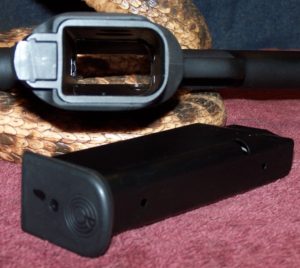 The PARA-USA 14.45 shipped with two 14-round, staggered-load magazines that are excellent. Made in Italy, the magazines are nicely stamped steel units with clearly marked witness holes. A polymer, anti-tilt, self-lubricating follower makes sliding rounds out of the magazine much easier on the pistol. With that said, sliding fourteen rounds into the magazines is not all that easy for the person loading the rounds. In fact, it is impossible to get 14-rounds in the magazines.
The PARA-USA 14.45 shipped with two 14-round, staggered-load magazines that are excellent. Made in Italy, the magazines are nicely stamped steel units with clearly marked witness holes. A polymer, anti-tilt, self-lubricating follower makes sliding rounds out of the magazine much easier on the pistol. With that said, sliding fourteen rounds into the magazines is not all that easy for the person loading the rounds. In fact, it is impossible to get 14-rounds in the magazines.
To say that the PARA 14.45 is a 14-round pistol should include the disclaimer that it is a 13+1 pistol, because 14-rounds are not going into the magazine, but 13 will without the aid of a loading assistant like the Mag Lula UpLULA, although the Mag Lula UpLULA loader does make loading a magazine or two faster and easier.
The magazines come with a removable polymer base-plate, which means that the magazines can be disassembled for maintenance.
MAINTENANCE
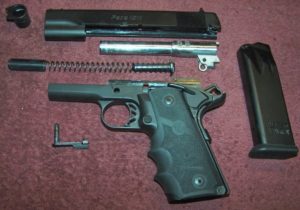 The PARA-USA 14.45 came with very little lubrication from the factory.
The PARA-USA 14.45 came with very little lubrication from the factory.
The disassembly and assembly of the PARA-USA 14.45 is as straightforward as 1911 pistol can be – with one caveat. The bushing wrench should definitely be used to remove the recoil spring plug. The barrel bushing is very tight when positioning it to clear the recoil spring plug. While the barrel bushing may loosen up over any number of disassembles, it is not easy to position when new.
While disassembly is made difficult by a tight barrel bushing, it can be downright frustrating when assembling the recoil spring plug to the slide. The PARA 14.45 is the first 1911, with the exception of those 1911s with a FLGRs, with which I have actually had to use a bushing wrench to disassemble and assemble the pistol.
RANGE DAY
With all of the pretty review stuff behind me, I can finally concentrate on seeing what the PARA 14.45 is capable of.
Initial range testing is just that – initial range testing. I get an idea of how the pistol is going to perform with a couple rounds of selected ammunition. In this case, it was to be a full magazine of Aguilla 230-grain FMJ, a full case of Perfecta 230-grain FMJ, a full magazine of locally-produced and factory-loaded 230-grain GDHP ammunition, and a handful of some home-grown 230-grain ammunition.
The plan was to bench rest for relative accuracy at seven-yards, 15-yards, and twenty-five yards. Then, I planned some off-hand Mozambique drills for comparing my “combat” POA with the expected POI.
One thing was sure, and as with the PARA-USA “Expert” 8-round version, the “80-Series” trigger was going to be a testament to my patience.
To speak of it up front, there was only one issue that occurred during the range session and that was what appeared to be a light primer strike. The offending round was recycled and fed fine.
The sights were spot on; slightly low at seven yards, point of aim at fifteen yards, and ever-so-slightly high at twenty-five yards from a bench rested position, shooting factory re-loads, and with a new 80-Series trigger. Then, it was time for some freehand work at ten yards. With the exception of a few fliers to the side (my fault), the Para 14-45 worked the vertical surprisingly well.
I had a hard time with the sights, as I usually door at an indoor range. Rather than relying on the three dots, I relied on the sight profile. Simply place the profile of the front sight in the notch of the rear sight and holes in the target would appear as close as I could get them placed. The trigger started smoothing out and perhaps after another one-hundred rounds or so the trigger will be suitable for more precise work. However, the trigger was more than suitable for the few Mozambique drills that I ran and well enough to put the majority of my shots in the bull and surrounding area. I was quite pleased with the first time out with this pistol.
There was another issue, but I can’t really call it an issue because I have yet to determine the cause of the issue.
One expended case that I picked up was so severely damaged at the mouth of the case that the case was destined never to be shot again. I did not have a camera with me, and probably should have brought the case home, but I neglected to do so. I appeared that the case had impacted something to the point that the crush point was jagged, sharply defined, bent inward on the case, and it was repeated on the direct opposite side of the case. The only thing that I could surmise was that the case impacted on something quite hard while exiting the pistol. However, no indication on the slide presented itself to warrant the damage to the case. The cause of the damage to the case; therefore, remains a mystery.
The grip size was not an issue with me, but the width was commented on by several of my shooting companions. The use of the Hogue Rubber Wraparound Grip with finger grooves is just a personal preference with me and I use them whenever possible, even on my MSRs.
UPDATE 09/07/2016:
Barrel Link Pin Issue
 After I had taken the PARA-USA 14.45 to the range and returned home, it was not until the next day that I could get around to cleaning the pistol completely, although I had run a Bore-Snake through the barrel several times prior to leaving the range.
After I had taken the PARA-USA 14.45 to the range and returned home, it was not until the next day that I could get around to cleaning the pistol completely, although I had run a Bore-Snake through the barrel several times prior to leaving the range.
I had disassembled the pistol in the normal fashion for a 1911, but when I tried to remove the barrel from the slide there was some resistance. More of a slight binding actually, and which was not there prior to the range outing. Was there a problem, Houston?
The binding would occur, it seemed, just as the Barrel Link lower lugs would enter the Recoil Spring Plug opening of the slide. I would have to physically push the barrel through the opening or pull the barrel through the opening. Push or pull, something was not right.
Even if the Barrel Link Pin had drifted a bit during normal operation of the pistol, the frame would keep the Barrel Link Pin within the confines of the frame. However, and due to the restrictive space that the barrel travels through when removing the barrel from the slide, a slight binding occurred at the point where the Barrel Link Pin had protruded from the barrel’s Barrel Link support lugs. Note that the Barrel Link Pin would not fall out of the barrel; it had simply drifted a bit.
Using a brass punch sized to the Barrel Link Pin, a Wheeler Engineering Universal Bench Block, and a light hammer, I was able to easily center the Barrel Link Pin within the Barrel Link support lugs. In fact, two very light taps of the hammer did the job very easily. Perhaps to easy, and that concerned me. But, was it a valid concern? Or, should I ask, is it a valid concern?
While I have experienced a “walking” Slide Stop on a 1911, this was the first time I had encountered a Barrel Link Pin that moved on a 1911 – and I have owned a few 1911s.
There are two answers that address a “walking” Barrel Link Pin issue:
- Stake the Lower Lug at the Barrel Link Pin to prevent the Barrel Link Pin from drifting, or
- Leave well enough alone
I decided to leave well enough alone.
Unless the Barrel Link Pin is worn to the point that the Barrel Link has a significant amount of lateral play at the Barrel Link Pin, everything should be fine. The Barrel Link should rotate freely around the Barrel Link Pin and may even have some side-to-side and a slight amount of up and down play within the Lower Lugs. Now, I am not talking about a lot of play, just an ever-so-slight amount; the Barrel Link must move freely around the axis of the Barrel Link Pin and should be adequately lubricated to prevent excessive wear on both parts. On the other hand, if the Barrel Link Pin is worn excessively, or if the Barrel Link is worn excessively, replacing the Barrel Link is an option and is something that should be undertaken by a qualified gun smith as the Barrel Link affects timing and barrel un-lock and lock-up, but that is a discussion for a different time.
As it is, the Barrel Link Pin has been centered in the Lower Lugs and functioning of the pistol is not affected; that is the main thing since this pistol is relatively new, not broken in yet, and only time and use will tell if the “walking” Barrel Link Pin is an issue worth rectifying. At this point, it is not an issue.
DON’ TAKE MY WORD FOR IT:
While there are not many reviews on my particular pistol, the blued version of the PARA-USA 14.45, there are reviews regarding its stainless-steeled brother. With that said, here is a brief list of the reviews that I have found regarding the PARA-USA 14.45:
- BREAKING: Remington Kills Para USA Brand: http://www.thetruthaboutguns.com/2015/02/foghorn/breaking-remington-kills-para-usa-brand/
- Para USA P14-45 | Gun Review: http://www.personaldefenseworld.com/2013/12/para-usa-p14-45-gun-review/2/
- Shooting the Para Expert Stainless and Pro Custom 14.45 1911 45 ACP Pistols – Gunblast.com: https://www.youtube.com/watch?v=XwzYktb2XEg
- Para USA P14-45: http://www.guns.com/reviews/para-usa-p14-45/
RESOURCES:
The PARA-USA 14.45 is only one of the many fine 1911s coming out of PARA-USA. Below is a link to the PARA-USA sight and also a link for the grip that I use with the PARA-USA 14.45.
- PARA-USA: http://www.para-usa.com/2013/index.php
- Hogue Rubber Grip Para ordnance P-14 Rubber Grips with Finger Grooves: https://www.amazon.com/Hogue-Rubber-ordnance-Finger-Grooves/dp/B000H6W9QK/ref=sr_1_1?ie=UTF8&qid=1473004676&sr=8-1&keywords=Hogue+14-45+grip
![]()


